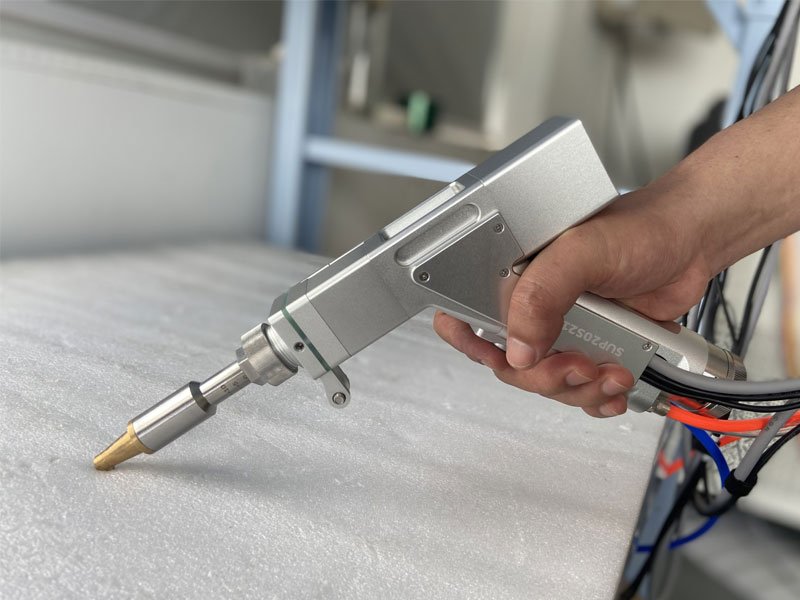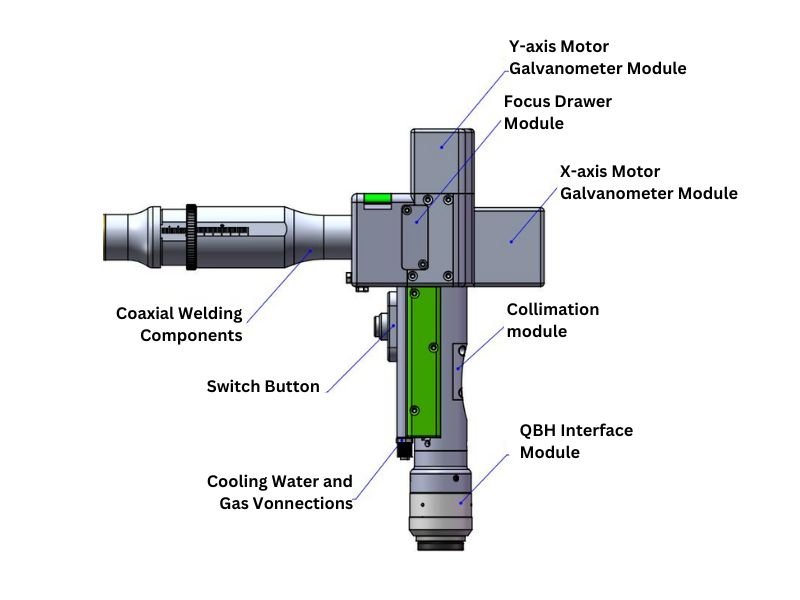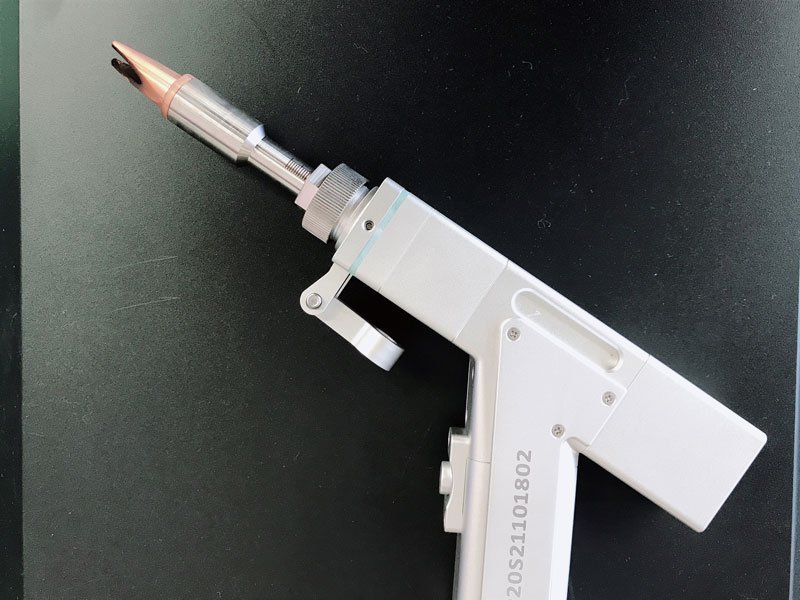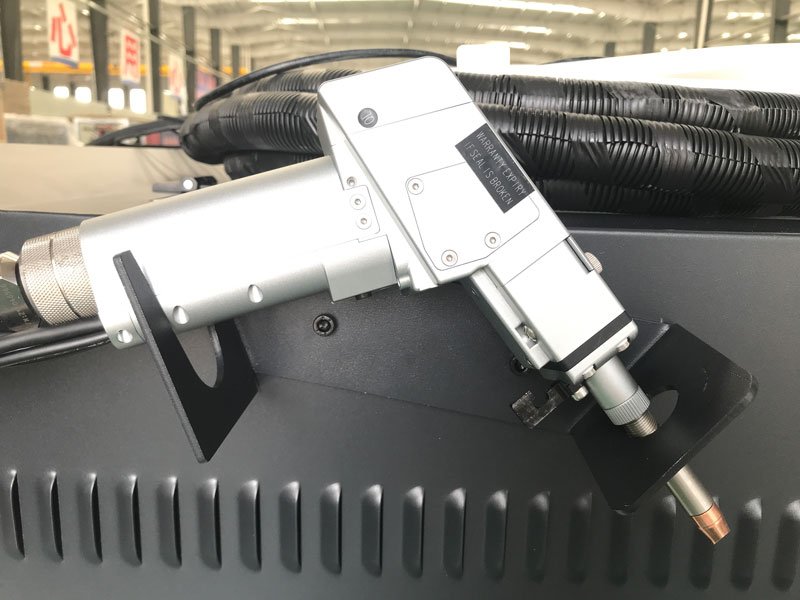Handheld laser welding heads offer a versatile and efficient solution for a wide range of welding applications. They provide precise control, high welding speeds, and minimal heat input, making them ideal for delicate and intricate workpieces. This introduction explores the key features, benefits, and applications of the best handheld laser welding heads, highlighting their advantages in various industries.

What is Handheld Laser Welding Head
Laser welding head refers to the joint part of laser welding, which is often one of the most important parts in the welding process. The quality of laser welding head directly affects the strength, sealing, corrosion resistance and other properties of the welding joint, and is also one of the keys to inspect the welding quality.
A handheld laser welding head is a portable welding tool that utilizes laser technology to fuse materials together. It consists of a laser source, a delivery system, and a welding head. The laser source generates a high-intensity laser beam, which is directed through the delivery system to the welding head. The welding head focuses the laser beam onto the workpiece, creating a localized heat source that melts the material, forming a weld.
Type of Handheld Laser Welding Head
Laser deep welding head
Laser deep welding head usually connects the edges of two adjacent parts with a complete welding plane. The depth of the welding head is generally greater than 1.5 times the thickness of the welding material, forming a weld form in which the vertical surface of the welding head and the contact surface are integrated. This type of weld has high strength and strong corrosion resistance, and is suitable for fields that require high strength, high sealing and corrosion resistance.
Laser pit welding head
The laser pit welding head uses the pit formed by laser between relatively moving parts to achieve a welded fixed connection. The welding head is a circular, conical or spherical pit. In order to improve the quality and strength of the weld, this weld needs to be laser processed multiple times, which is suitable for fields that require high-precision welding.
Laser flat head welding head
The laser flat head welding head is heated by laser to melt the contact plane and solidify each other. When the laser beam leaves the component, a welding head is formed, and the head is flat. This type of weld can well maintain the shape and size of the material, and is suitable for fields that need to maintain the shape of the material.
Laser spot welding head
The laser spot welding head focuses the laser beam to a very small point, moves the parts around the welding point and heats the welding contact. The welding head size reaches 1/4 of the conventional welding head, which is suitable for welding thin plate materials and small contact areas of high-demand products.

Wobble Welding Head
Function:
A wobble welding head features a mechanism that oscillates the laser beam in a pre-defined pattern. This oscillation can be circular, elliptical, or even a more complex waveform.
Benefits:
- Larger Weld Zones: The wobbling motion of the beam creates a wider weld zone compared to a stationary beam, enhancing joint strength and penetration depth.
- Improved Weld Quality: Wobbling can help reduce porosity and improve weld uniformity, particularly when welding thicker materials.
Limitations:
- Slower Speeds: Compared to galvanometer scanners, wobble heads operate at slower speeds due to the mechanical oscillation mechanism.
- Limited Pattern Flexibility: The range of achievable weld patterns with wobble heads is generally less diverse compared to scanner heads.
Benefits of Using a Handheld Laser Welding Head
Precisione. A highly focused laser beam enables complex and precise welds even in hard-to-reach areas. This level of precision is essential for precision-critical applications, such as the aerospace, medical, and electronics industries.
Efficiency. The concentrated laser energy enables fast welds, which significantly reduces production time. This efficiency increases productivity and saves costs, making it an ideal solution for high-volume manufacturing environments.
Flessibilità. Unlike traditional welding methods, laser welding does not require the use of consumables such as electrodes or shielding gases. This eliminates the need for frequent changeouts, reduces downtime, and allows for seamless welding of different materials and thicknesses.
Versatility. These devices can be easily operated and used in a variety of locations, including field repairs and remote areas. This portability makes them ideal for applications with limited accessibility or where welding needs to be performed in confined spaces.
Environmental Advantages. Laser welding produces minimal fumes and spatter, reducing ventilation needs and improving workplace air quality. This environmentally friendly feature makes it a sustainable choice for industries seeking to minimize environmental impact.
Relatively easy to operate. With proper training, operators can quickly master the technology and achieve high-quality welds. This ease of use makes it suitable for a wider range of industries and applications.
In summary, handheld laser welding heads offer a perfect combination of precision, efficiency, flexibility, portability, environmental friendliness, and ease of use. These advantages make them a valuable tool for a wide range of industries, from manufacturing and construction to aerospace and medical. By leveraging the advantages of handheld laser welding heads, companies can increase productivity, improve product quality, and gain a competitive advantage in today’s demanding markets.

Tips for Using a Handheld Laser Welding Head Safely and Effectively
Handheld laser welding heads offer unparalleled precision and efficiency for a wide range of welding applications. However, ensuring their safe and effective operation is paramount. Here are some essential tips to guide you:
Safety First:
* Always wear appropriate personal protective equipment (PPE), including laser safety glasses, gloves, and a welding helmet.
* Ensure the work area is well-ventilated to prevent exposure to harmful fumes.
* Keep the laser beam away from flammable materials and reflective surfaces.
Proper Setup:
* Calibrate the laser head according to the manufacturer’s instructions.
* Secure the workpiece firmly to prevent movement during welding.
* Adjust the laser power and focus to optimize weld quality.
Welding Techniques:
* Use a steady hand and maintain a consistent welding speed.
* Keep the laser beam perpendicular to the workpiece surface.
* Overlap welds slightly to ensure a strong bond.
* Allow the weld to cool completely before handling.
Maintenance and Troubleshooting:
* Regularly clean the laser head lens to prevent debris buildup.
* Inspect the laser beam for any irregularities or damage.
* If the laser head malfunctions, immediately stop using it and contact the manufacturer for assistance.
Additional Tips:
* Practice on scrap material before welding on actual components.
* Use a welding jig or fixture to ensure precise alignment.
* Consider using a laser welding fume extractor to minimize exposure to harmful fumes.
* Stay informed about the latest advancements in laser welding technology to enhance your skills.
By following these tips, you can safely and effectively utilize a handheld laser welding head to achieve high-quality welds with precision and efficiency. Remember, safety should always be your top priority, and proper training and adherence to best practices are essential for successful laser welding operations.

Choosing the Right Handheld Laser Welding Head
Selecting the optimal handheld laser welding head is crucial for achieving precise and efficient welding results. Here are key factors to consider when making your choice:
Power Output:The power output of the laser welding head determines the thickness and type of materials it can weld. Higher power outputs enable welding of thicker materials, while lower power outputs are suitable for thinner materials.
Wavelength:The wavelength of the laser beam affects the absorption and penetration depth in the material. Shorter wavelengths, such as those emitted by fiber lasers, provide higher absorption and shallower penetration, making them ideal for welding thin materials. Longer wavelengths, such as those emitted by CO2 lasers, offer deeper penetration and are suitable for welding thicker materials.
Spot Size: The spot size refers to the diameter of the laser beam at the workpiece. A smaller spot size results in a more concentrated beam, allowing for precise welding of small features. A larger spot size provides a wider beam, enabling faster welding of larger areas.
Beam Quality: The beam quality of the laser welding head determines the consistency and stability of the laser beam. A higher beam quality results in a more focused and uniform beam, leading to improved weld quality and reduced spatter.
Ergonomics: The ergonomics of the handheld laser welding head play a significant role in operator comfort and productivity. A lightweight and well-balanced head reduces fatigue and allows for extended welding sessions.
Additional Features: Some handheld laser welding heads offer additional features, such as automatic wire feeding, seam tracking, and remote control. These features can enhance welding efficiency and accuracy.
Applicazioni: The choice of handheld laser welding head also depends on the specific applications it will be used for. For example, welding in confined spaces requires a compact and maneuverable head, while welding large structures may necessitate a head with a longer reach.
Selecting the right handheld laser welding head is essential for optimizing welding performance. By considering factors such as power output, wavelength, spot size, beam quality, ergonomics, and additional features, you can choose a head that meets your specific needs and ensures high-quality welding results.
Articolo correlato
- How To Choose Single Pendulum And Double Pendulum Handheld Laser Welding System
- Complete Guida:Single Pendulum Vs Double Pendulum Handheld Laser Welding Head
- How Much Is A Quick And Easy Laser Welding Tool Price?
- Features About Cina Shenzhen Qilin Laser Welding Head
- How To Reduce The Loss Of The Handheld Laser Welding Head
- Che cosa Are The Different Types Of Welding Machines Processes
